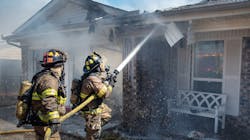Editor's note: The author served on the Small Business Advocacy Review Panel of OSHA's Potential Emergency Response Standard representing the Libertytown, MD, Volunteer Fire Department and our nation’s volunteers. The recently completed 370-page report recommendations can be found at at this link or here.
NFPA standards have long been the gold standard for the nation’s fire and rescue service. Over the years, this standard-making body has extended into developing consensus standards for every facet of the fire and EMS service. Firefighter training standards, medical/physical standards, apparatus standards and numerous operational standards are viewed as the industry standards our fire and rescue departments strive to achieve.
Standards are not legal and binding, but can be used during civil litigation as the industry standard that should utilized. Though failing to follow the standard does not result in criminal actions, a court could hold an emergency service negligent for failing to comply with the established and accepted standards.
To adopt NFPA standards into regulation would effectively place many fire and rescue departments in non-compliance and that could have a disastrous effect, particularly on the nation’s volunteer fire and rescue service.
OSHA looks to fire service regulations
The U.S. Department of Labor's Occupational Safety & Health Administration (OSHA) is presently considering adopting a regulation that has the potential of creating an environment of non-compliance that simply cannot be corrected. Even major fire and rescue organizations that are fully career or combination departments would be faced with unfunded legal mandates that will pose a tremendous fiscal burden on fire departments, municipalities and county governments.
There is a major push by OSHA to implement a health and safety standard that includes mandatory medical physicals, mental health and wellness, job performance requirements and physical fitness requirements.
I fully support and endorse every effort to enhance the health of personnel. However, many departments simply cannot afford the financial burden of the regulations as proposed by OSHA. The implementation of NFPA 1582, NFPA1500 and aggressive programs such as the 16 Life Safety Initiatives have dramatically reduced operational line-of-duty deaths (LODDs) during the last 40 years through education and voluntary compliance of many fire and rescue companies.
Unfortunately, every fire department does not have the manpower or financial resources to fully implement NFPA 1582 and most likely would never be able to comply with mandatory regulations. Many fire and EMS departments struggle each day just to meet daily expenses to keep the doors open and apparatus running.
Some volunteer fire departments have an operating budget of less than $10,000 a year. Carnivals, bingo and chicken dinner events are held just to raise funds to meet monthly bills. Even larger suburban and metropolitan fire and emergency service organizations struggle to recruit personnel and convince political leaders to provide funding.
Volunteer FDs lack funding
One size does not fit all. The volunteer fire and rescue service of our nation is as varied as the nation’s climate from the very large metropolitan volunteer and combination fire departments with more than 100 members to one engine rural departments that are lucky to have three people responding to an incident. The thousands of emergency service organizations of our country stand as centurions protecting villages, cities and counties throughout our nation.
A fire company that has limited funds will be forced to choose between paying the insurance bill or providing physicals to members. As many volunteer fire departments depend on older members, medical physicals could easily cost $1,000 per person.
Even more of a concern would be the proposed requirement to assure members are fit for duty. Pre-employment or member testing and fit-for-duty evaluations would not only be time consuming, but also a detriment to potential new and incumbent members. Our nation is already suffering from a decrease in volunteer participation in fire and EMS.
Many volunteer companies are struggling to recruit and retain volunteers. Adding more time to what is often an already somewhat burdensome process will pose another barrier to keeping members on staff or convincing the public to join their local fire department. Though most companies do provide some basic form of evaluations for fitness for new personnel, to mandate a specific regiment as outlined by NFPA 1583 would be time consuming and burdensome, ultimately defeating the purpose.
Other proposed regulations based on NFPA standards could ultimately create voids in emergency services in many communities. The 10-year gear requirement is well intentioned, but in many situations the turnout gear rarely sees interior firefighting. Many small departments don’t have the financial ability to replace gear every 10 years.
And, though the FIRE Act Grant is presently available for such purchases, these funds are limited.
The 10-year gear standard is well intentioned. But, in many situations in smaller, slower departments, the turnout gear rarely sees interior firefighting. Many small departments do not have the financial ability to replace gear every 10 years. And though the FIRE Act Grant is presently available for such purchases, these funds are limited.
The present standard for two sets of gear would be cost prohibitive for many fire departments, even for many large career departments. Adopting these standards into regulation will again be unachievable for many departments. It will require many hundreds of millions of dollars more than the present FIRE Act budget to provide financial assistance needed nationwide if these standards are required and adopted into regulation.
Presently, OSHA conducts operations with a more positive attitude, working with organizations to meet compliance rather than the more government harsh hammer of the past. Even so, many fire and rescue companies will never be able to comply if these proposed NFPA standards become regulations. No one can predict the actions of OSHA against fire and rescue companies that are non-compliant, which could potentially force many departments out of business, thus jeopardizing public safety.
The efforts of fire and rescue companies of our nation in the last two decades to address health and safety are evident when reviewing past history of LODDs. Our service has continued to see a decrease in operational LODDs in the last 40 years due to the continued work by departments to implement NFPA standards. Efforts to decrease exposure to cancer and increase medical evaluations are ongoing. Though I am very supportive of efforts to achieve every NFPA standard, utilizing these standards as OSHA regulations will not have the desired effect, but rather pose an unnecessary and often unachievable legal regulation that could create an increased void of volunteers and service delivery to communities across our country.
About the Author

Clarence Jewell
Clarence “Chip” Jewell is in his 54th year as an active volunteer. He is a life member of the Libertytown, MD, Volunteer Fire Department and the Junior Fire Co. No. 2 in Frederick, MD. Jewell retired in 2017 as the deputy chief/director of the Frederick County, MD, Division of Volunteer Fire & Rescue Services, a combination service that consists of 25 independent fire and rescue companies, 600 operational volunteers, 1,700 volunteers and more than 400 career personnel. He has a bachelor's degree in fire science from the University of Maryland/University College. Jewell is a management-level instructor for the Maryland Fire and Rescue Institute. He is active on several committees of the Maryland State Firemen’s Association.
